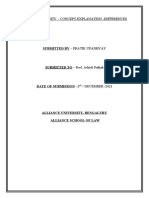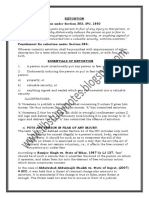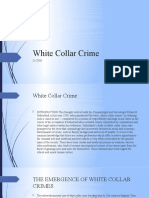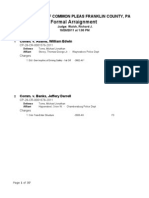0 ratings0% found this document useful (0 votes)
30 viewsRobbery and Dacoity
Robbery and Dacoity
Uploaded by
Siddhant Sodhia- Robbery involves theft or extortion accompanied by wrongful restraint, fear of instant harm, or attempts thereof. Theft becomes robbery if such acts are used to commit or escape from theft. Extortion becomes robbery if the extortionist instills fear of instant harm while demanding property.
- Dacoity involves five or more people committing or attempting robbery together or aiding such acts. It is punished more severely than robbery.
- The document outlines the key elements that distinguish robbery, dacoity, theft and extortion and provides illustrations of cases to exemplify these legal definitions and differences. It also discusses the punishments prescribed for different robbery and dacoity offenses under Indian law.
Copyright:
© All Rights Reserved
Available Formats
Download as PPTX, PDF, TXT or read online from Scribd
Robbery and Dacoity
Robbery and Dacoity
Uploaded by
Siddhant Sodhia0 ratings0% found this document useful (0 votes)
30 views21 pages- Robbery involves theft or extortion accompanied by wrongful restraint, fear of instant harm, or attempts thereof. Theft becomes robbery if such acts are used to commit or escape from theft. Extortion becomes robbery if the extortionist instills fear of instant harm while demanding property.
- Dacoity involves five or more people committing or attempting robbery together or aiding such acts. It is punished more severely than robbery.
- The document outlines the key elements that distinguish robbery, dacoity, theft and extortion and provides illustrations of cases to exemplify these legal definitions and differences. It also discusses the punishments prescribed for different robbery and dacoity offenses under Indian law.
Original Description:
Robbery and Dacoity
Copyright
© © All Rights Reserved
Available Formats
PPTX, PDF, TXT or read online from Scribd
Share this document
Did you find this document useful?
Is this content inappropriate?
- Robbery involves theft or extortion accompanied by wrongful restraint, fear of instant harm, or attempts thereof. Theft becomes robbery if such acts are used to commit or escape from theft. Extortion becomes robbery if the extortionist instills fear of instant harm while demanding property.
- Dacoity involves five or more people committing or attempting robbery together or aiding such acts. It is punished more severely than robbery.
- The document outlines the key elements that distinguish robbery, dacoity, theft and extortion and provides illustrations of cases to exemplify these legal definitions and differences. It also discusses the punishments prescribed for different robbery and dacoity offenses under Indian law.
Copyright:
© All Rights Reserved
Available Formats
Download as PPTX, PDF, TXT or read online from Scribd
Download as pptx, pdf, or txt
0 ratings0% found this document useful (0 votes)
30 views21 pagesRobbery and Dacoity
Robbery and Dacoity
Uploaded by
Siddhant Sodhia- Robbery involves theft or extortion accompanied by wrongful restraint, fear of instant harm, or attempts thereof. Theft becomes robbery if such acts are used to commit or escape from theft. Extortion becomes robbery if the extortionist instills fear of instant harm while demanding property.
- Dacoity involves five or more people committing or attempting robbery together or aiding such acts. It is punished more severely than robbery.
- The document outlines the key elements that distinguish robbery, dacoity, theft and extortion and provides illustrations of cases to exemplify these legal definitions and differences. It also discusses the punishments prescribed for different robbery and dacoity offenses under Indian law.
Copyright:
© All Rights Reserved
Available Formats
Download as PPTX, PDF, TXT or read online from Scribd
Download as pptx, pdf, or txt
You are on page 1of 21
Robbery and Dacoity
Neeraj Kumar Gupta
Class Protocol for Students
● Join your Classes on time.
● Avoid leaving the lectures in between.
● Respect your Peers and your Instructors.
● Keep your Online Chats focused on learning.
● Ensure you are in the Professional Attire for learning.
● Turn on the microphone to ask your queries and to respond.
● Contribute in the process of Learning by being an Active Participant.
Session Learning Outcome
At the end of the session, students will be able to
● Understand the meaning of Robbery and Dacoity
● Draw the line between robbery dacoity, theft and extortion
Robbery (390)
● In all robbery there is either theft or extortion.
● When theft is robbery.—Theft is “robbery” if, in order to the committing of the theft, or in
committing the theft, or in carrying away or attempting to carry away property obtained by
the theft, the offender, for that end, voluntarily causes or attempts to cause to any person
death or hurt or wrongful restraint, or fear of instant death or of instant hurt, or of instant
wrongful restraint.
● When extortion is robbery.—Extortion is “robbery” if the offender, at the time of committing
the extortion, is in the presence of the person put in fear, and commits the extortion by
putting that person in fear of instant death, of instant hurt, or of instant wrongful restraint to
that person or to some other person, and, by so putting in fear, induces the person so put
in fear then and there to deliver up the thing extorted.
Contd…
● Explanation.—The offender is said to be present if he is sufficiently near to put
the other person in fear of instant death, of instant hurt, or of instant wrongful
restraint.
Illustrations
● (a) A holds Z down and fraudulently takes Z’s money and jewels from Z’s clothes without Z’s consent.
Here A has committed theft, and in order to the committing of that theft, has voluntarily caused
wrongful restraint to Z. A has therefore committed robbery.
● (b) A meets Z on the high roads, shows a pistol, and demands Z’s purse. Z in consequence,
surrenders his purse. Here A has extorted the purse from Z by putting him in fear of instant hurt, and
being at the time of committing the extortion in his presence. A has therefore committed robbery.
● (c) A meets Z and Z’s child on the high road. A takes the child and threatens to fling it down a
precipice, unless Z delivers his purse. Z, in consequence delivers his purse. Here A has extorted the
purse from Z, by causing Z to be in fear of instant hurt to the child who is there present. A has
therefore committed robbery on Z.
● (d) A obtains property from Z by saying—“Your child is in the hands of my gang, and will be put to
death unless you send us ten thousand rupees”. This is extortion, and punishable as such; but it is not
robbery, unless Z is put in fear of the instant death of his child.
Essentials… Theft is Robbery
● There cannot be Robbery if either there is no theft or extortion (So all the
ingredients of theft or extortion, as the case may be applicable)
● In case of theft…In order of committing/ In committing/carrying away/
attempting to carry away the property
● Causes death, hurt, wrongful restraint or
● Causes the fear of instant death, instant hurt, instant wrongful restraint or
● Attempts to cause death, hurt, wrongful restraint
● In 382 there is only preparation and in 390, there is causation of attempt
atleast.
Essentials… Extortion is Robbery
● In case of extortion…Commits extortion is in the presence of the
person put in fear
● Fear relates to the instant death, instant hurt or instant wrongful
restraint
● To that person or any other person
● Inducement to deliver the property/ valuable security then and
there
Robbery explained
● Robbery is aggravated form of theft or extortion.
● The distinction as explained in the section may not be found when
the incident is occurring. It may be a situation that it is half theft
and half extortion
● The phrase “for that end” is required to understood carefully as it
distinguishes the situation from theft with violence
Punishment for Robbery (S. 392)
● Whoever commits robbery shall be punished with rigorous
imprisonment for a term which may extend to ten years, and shall
also be liable to fine; and, if the robbery be committed on the
highway between sunset and sunrise, the imprisonment may be
extended to fourteen years.
S. 394 Voluntarily causing hurt in committing robbery
● If any person, in committing or in attempting to commit robbery,
voluntarily causes hurt, such person, and any other person jointly
concerned in committing or attempting to commit such robbery,
shall be punished with imprisonment for life, or with rigorous
imprisonment for a term which may extend to ten years, and shall
also be liable to fine.
Dacoity (S. 391)
● When five or more persons conjointly commit or attempt to commit
a robbery, or where the whole number of persons conjointly
committing or attempting to commit a robbery, and persons
present and aiding such commission or attempt, amount to five or
more, every person so committing, attempting or aiding, is said to
commit “dacoity”.
Essentials of Dacoity
● Five or more persons must act in association or in concerted
manner
● Such act must be to robbery or attempt to commit robbery
● The five persons must consist of those who themselves commit or
attempt to commit robbery or those who are present and aid the
principle actors in the commission or attempt of such robbery
Punishment of Dacoity (395)
● Whoever commits dacoity shall be punished with imprisonment for
life, or with rigorous imprisonment for a term which may extend to
ten years, and shall also be liable to fine.
Dacoity with Murder (396)
● If any one of five or more persons, who are conjointly committing
dacoity, commits murder in so committing dacoity, every one of
those persons shall be punished with death, or imprisonment for
life, or rigorous imprisonment for a term which may extend to ten
years, and shall also be liable to fine.
● The same transaction is important thing to be kept in mind.
Making Prep.. To commit Dacoity (399)
● Whoever makes, any preparation for committing dacoity, shall be
punished with rigorous imprisonment for a term which may extend
to ten years, and shall also be liable to fine.
Belonging to gang of dacoits (400)
● Whoever, at any time after the passing of this Act, shall belong to a
gang of persons associated for the purpose of habitually
committing dacoity, shall be punished with imprisonment for life, or
with rigorous imprisonment for a term which may extend to ten
years, and shall also be liable to fine.
Assembling for… committing of dacoity (402)
● Whoever, at any time after the passing of this Act, shall be one of
five or more persons assembled for the purpose of committing
dacoity, shall be punished with rigorous imprisonment for a term
which may extend to seven years, and shall also be liable to fine.
Dacoity Puishable at all four stages
● Assembling is punishable (Sharing the intent)
● Preparation is punishable
● Attempt of dacoity is equal to dacoity
Theft Extortion Robbery Dacoity
Movable Property All types of property Guess Guess
Without consent With consent (tainted Guess Guess
one)
It can be committed by One or more Guess Guess
one
No fear or compulsion Fear of compulsion for Guess Guess
the same or other person
Element of fear is absent Present Guess Guess
Taking Delivery Guess Guess
Punishment.
You might also like
- GUMSHOE Swords of The Serpentine PELGSS01 Adventurers Edition BlankDocument1 pageGUMSHOE Swords of The Serpentine PELGSS01 Adventurers Edition BlankPhil HypeNo ratings yet
- Robbery and DacoityDocument9 pagesRobbery and Dacoityastha100% (1)
- Robbery & DacoityDocument21 pagesRobbery & Dacoityritikas6676No ratings yet
- RobberyDocument4 pagesRobberyaparnaba2113No ratings yet
- Robbery DacoityDocument5 pagesRobbery DacoityMian KhalidNo ratings yet
- Till 502Document20 pagesTill 502HemanthNo ratings yet
- Robbery and DacoityDocument9 pagesRobbery and DacoityAmna EhsanNo ratings yet
- Robbery and DacoityDocument9 pagesRobbery and DacoityAmna EhsanNo ratings yet
- 2021 SFC ASR FINAL Offences PropertyDocument35 pages2021 SFC ASR FINAL Offences Propertyaditi shrivastavaNo ratings yet
- 19 Offences Against Property-IDocument26 pages19 Offences Against Property-Isrisunandha04No ratings yet
- Offences Against Property-IDocument26 pagesOffences Against Property-I21010324037No ratings yet
- Robbery Sem 4Document18 pagesRobbery Sem 4krapanshu rathiNo ratings yet
- Submitted By: Shagun Vishwanath Ballb (Semester 3) 1020202148Document16 pagesSubmitted By: Shagun Vishwanath Ballb (Semester 3) 1020202148Shagun VishwanathNo ratings yet
- Robbery and DacoityDocument5 pagesRobbery and DacoityEsha Javed100% (3)
- Ndore Nstitute of AW: B.A.LL.B. (HONS)Document15 pagesNdore Nstitute of AW: B.A.LL.B. (HONS)Manas BhawsarNo ratings yet
- Offences Against PropertyDocument27 pagesOffences Against Propertyviren duggalNo ratings yet
- Specific Offences Against Property: By-Gaurav Shukla Faculty of Law, DSMNRUDocument10 pagesSpecific Offences Against Property: By-Gaurav Shukla Faculty of Law, DSMNRUGaurav ShuklaNo ratings yet
- Extortion and robberyDocument3 pagesExtortion and robberyAliza SikanderNo ratings yet
- IPC Questions AnswersDocument3 pagesIPC Questions AnswersVedant ShahdeoNo ratings yet
- Offences Against PropertyDocument6 pagesOffences Against PropertyJayesh RajputNo ratings yet
- unit 4Document13 pagesunit 4drmanav2048No ratings yet
- unit 4Document14 pagesunit 4drmanav2048No ratings yet
- Q-1 What Are The Ingrediants of The Offence of Theft and Also Explain When Theft Become Robbery? Ans: 1. TheftDocument31 pagesQ-1 What Are The Ingrediants of The Offence of Theft and Also Explain When Theft Become Robbery? Ans: 1. TheftKhizar HayatNo ratings yet
- Robbery and DacoityDocument4 pagesRobbery and Dacoityashwanipratap997No ratings yet
- Offences Affecting The Human BodyDocument5 pagesOffences Affecting The Human Bodysalman jamilNo ratings yet
- 20-Wrongful Restraint Wrongful ConfinementDocument28 pages20-Wrongful Restraint Wrongful ConfinementAmani NasuhaNo ratings yet
- RobberyDocument13 pagesRobberySyed Imran AdvNo ratings yet
- IPC Questions AnswersDocument4 pagesIPC Questions AnswersVedant ShahdeoNo ratings yet
- Robbery and Dacoity Explanation & DifferencesDocument11 pagesRobbery and Dacoity Explanation & DifferencesUpadhyay Prateek100% (1)
- Robbery PPC Ll.b3 22 IjtDocument7 pagesRobbery PPC Ll.b3 22 IjtNABIL AFZALNo ratings yet
- AbductionDocument7 pagesAbductionAkash Kumar ShialNo ratings yet
- Alishan Shaikh Law of CrimesDocument10 pagesAlishan Shaikh Law of CrimesAlishan ShaikhNo ratings yet
- Theft ExtortionDocument26 pagesTheft ExtortionSiddhant SodhiaNo ratings yet
- Abduction in MalaysiaDocument32 pagesAbduction in MalaysiaNurAzreen100% (2)
- Abduction Law in MalaysiaDocument30 pagesAbduction Law in Malaysiaemyliaatan100% (1)
- Robbery in IPCDocument4 pagesRobbery in IPCChengchang MarakNo ratings yet
- Indore Institute of Law: Affiliated To Davv & BciDocument8 pagesIndore Institute of Law: Affiliated To Davv & BciManas BhawsarNo ratings yet
- Distinction Between TheftDocument4 pagesDistinction Between TheftAditi sharmaNo ratings yet
- Dr. Shakuntala Misra National Rehabilitation University, LucknowDocument9 pagesDr. Shakuntala Misra National Rehabilitation University, LucknowGaurav ShuklaNo ratings yet
- Department of LL.B: Criminal Law IIDocument10 pagesDepartment of LL.B: Criminal Law IIangell_aisshaNo ratings yet
- Indian Penal Code-II Project Sem-6Document12 pagesIndian Penal Code-II Project Sem-6sssNo ratings yet
- Force, Criminal Force and Assault PDFDocument9 pagesForce, Criminal Force and Assault PDFadammjoness2No ratings yet
- Assignment 5 DacoityDocument2 pagesAssignment 5 DacoityKo Gree KyawNo ratings yet
- Ipc Unit 3Document28 pagesIpc Unit 3Sidhesh MohantyNo ratings yet
- PPC 2Document10 pagesPPC 2Saqlain HyderNo ratings yet
- TheftDocument3 pagesTheft61 Neelesh KumarNo ratings yet
- Kidnapping and AbductionDocument26 pagesKidnapping and AbductionrajammalsupramaniamNo ratings yet
- Theft Comes Under The Purview of Offences Against Property Which Extends From Section 378 To Section 462Document29 pagesTheft Comes Under The Purview of Offences Against Property Which Extends From Section 378 To Section 462Ashraful Islam HamimNo ratings yet
- Criminal Events Vocabulary and Other Deduction Expressions!Document3 pagesCriminal Events Vocabulary and Other Deduction Expressions!Torres Mauricio Kevin IanNo ratings yet
- Crime and Punishment 2Document11 pagesCrime and Punishment 2Mirely RojasNo ratings yet
- Aggravated Presence CommittedDocument11 pagesAggravated Presence CommittedAbhishek YadavNo ratings yet
- Notes 16012023 035120pm 18062023 061554amDocument3 pagesNotes 16012023 035120pm 18062023 061554amMeer SalarNo ratings yet
- Ipc KidnappingDocument13 pagesIpc KidnappingannuNo ratings yet
- Dhvit Shah Law of CrimesDocument6 pagesDhvit Shah Law of Crimesdhvit2002No ratings yet
- Ipc ProjectDocument13 pagesIpc Projectanon_909832531No ratings yet
- Criminal Trespass.: Chapter XVII (441-462) of IPC Criminal Trespass - Indian Penal Code (Ipc)Document9 pagesCriminal Trespass.: Chapter XVII (441-462) of IPC Criminal Trespass - Indian Penal Code (Ipc)manjulata_456137437No ratings yet
- Extortion Definition of Extortion Under Section 383, IPC, 1860Document4 pagesExtortion Definition of Extortion Under Section 383, IPC, 1860Riya SinghNo ratings yet
- New RobberyDocument20 pagesNew RobberyWilliam OkumuNo ratings yet
- Robbery in GeneralDocument11 pagesRobbery in Generaljoeladam098No ratings yet
- DacoityDocument5 pagesDacoitySony DonthuNo ratings yet
- Out of PlaceDocument18 pagesOut of PlaceSiddhant SodhiaNo ratings yet
- Computation of Period of LimitationDocument43 pagesComputation of Period of LimitationSiddhant SodhiaNo ratings yet
- Dictionary of SociologyDocument14 pagesDictionary of SociologySiddhant SodhiaNo ratings yet
- EnviornmentDocument17 pagesEnviornmentSiddhant SodhiaNo ratings yet
- Second Appeal, Reference, Review RevisionDocument69 pagesSecond Appeal, Reference, Review RevisionSiddhant SodhiaNo ratings yet
- Evidence HandmadeDocument17 pagesEvidence HandmadeSiddhant SodhiaNo ratings yet
- Convocation Name Correction NoticeDocument55 pagesConvocation Name Correction NoticeSiddhant SodhiaNo ratings yet
- Legal Personality of Corporations PDFDocument12 pagesLegal Personality of Corporations PDFSiddhant SodhiaNo ratings yet
- Theft ExtortionDocument26 pagesTheft ExtortionSiddhant SodhiaNo ratings yet
- ChargeDocument25 pagesChargeSiddhant SodhiaNo ratings yet
- Capstone Artifact Elcc Standard 1Document7 pagesCapstone Artifact Elcc Standard 1api-404096250No ratings yet
- Young Samurai FireDocument150 pagesYoung Samurai FireRizal Aghni100% (2)
- Project in Language: Submitted By: Marie Nelle Limbo Submitted To: Ms. Olive LattaoDocument6 pagesProject in Language: Submitted By: Marie Nelle Limbo Submitted To: Ms. Olive LattaoNel Mark LimboNo ratings yet
- Armed Off-Duty Cop Sends Suspected Carjackers Fleeing As Crime SpiralDocument1 pageArmed Off-Duty Cop Sends Suspected Carjackers Fleeing As Crime Spiraled2870winNo ratings yet
- Face Book History of Face BookDocument3 pagesFace Book History of Face BookJeromeEganaAlbardaNo ratings yet
- H.P. Love Craft-TwilightTalesAgainDocument22 pagesH.P. Love Craft-TwilightTalesAgainEarl RinandNo ratings yet
- H-M-F-, AXXX XXX 345 (BIA March 29, 2017)Document7 pagesH-M-F-, AXXX XXX 345 (BIA March 29, 2017)Immigrant & Refugee Appellate Center, LLCNo ratings yet
- Ielts Foundation Chapter 6 Reading Part 1 AdaptedDocument2 pagesIelts Foundation Chapter 6 Reading Part 1 AdaptedlimlinliNo ratings yet
- Percentage Distribution of CICL by Sex: Age No. Percent 10 11 12 13 14 15 16 17 18 TotalDocument8 pagesPercentage Distribution of CICL by Sex: Age No. Percent 10 11 12 13 14 15 16 17 18 TotalShefferd BernalesNo ratings yet
- New Password B1 UT 6BDocument3 pagesNew Password B1 UT 6Bframo.tarnofirmoweNo ratings yet
- Police CodesDocument7 pagesPolice CodestigzzlopesNo ratings yet
- Women and Safety PaperDocument13 pagesWomen and Safety PapertlynndewittNo ratings yet
- Steven PayneDocument5 pagesSteven PaynesamtlevinNo ratings yet
- United States v. Stan Leavitt, Glen Leavitt, and Lee Johnson, 599 F.2d 355, 10th Cir. (1979)Document12 pagesUnited States v. Stan Leavitt, Glen Leavitt, and Lee Johnson, 599 F.2d 355, 10th Cir. (1979)Scribd Government DocsNo ratings yet
- Shoplifting Its Symbolic Motivationrouke1957Document5 pagesShoplifting Its Symbolic Motivationrouke1957Chris MartinNo ratings yet
- Mixed RephrasingDocument14 pagesMixed RephrasingAndres MinguezaNo ratings yet
- DocumentDocument3 pagesDocumentjainamjainNo ratings yet
- de hsg tỉnh 11Document6 pagesde hsg tỉnh 11ngocanhvu7bNo ratings yet
- Maxims Statutory ConstructionDocument2 pagesMaxims Statutory ConstructionElimar JoseNo ratings yet
- Possible Compromise in Works: He Imes EaderDocument38 pagesPossible Compromise in Works: He Imes EaderThe Times LeaderNo ratings yet
- Gta 6Document5 pagesGta 6kryma09988No ratings yet
- White Collar Crime VIDocument16 pagesWhite Collar Crime VIhimanshi khivsaraNo ratings yet
- Oct. 26 Formal Arraignment ListDocument37 pagesOct. 26 Formal Arraignment ListPublic OpinionNo ratings yet
- Itec 85 - Information Assurance and SecurityDocument3 pagesItec 85 - Information Assurance and Securityhunter kurosakiNo ratings yet
- Anderson County Sheriff's Office: Country GlenDocument4 pagesAnderson County Sheriff's Office: Country Glenalpca8615No ratings yet
- The Good News - September/October 2010Document32 pagesThe Good News - September/October 2010United Church of GodNo ratings yet
- Gonzales Cannon Dec. 13 IssueDocument26 pagesGonzales Cannon Dec. 13 IssueGonzales CannonNo ratings yet
- Terror in The ToyboxDocument36 pagesTerror in The ToyboxjhmcmullenNo ratings yet
- 11 Defendants Charged in 10 New DPS CasesDocument6 pages11 Defendants Charged in 10 New DPS CasesWXYZ-TV Channel 7 DetroitNo ratings yet


































































































